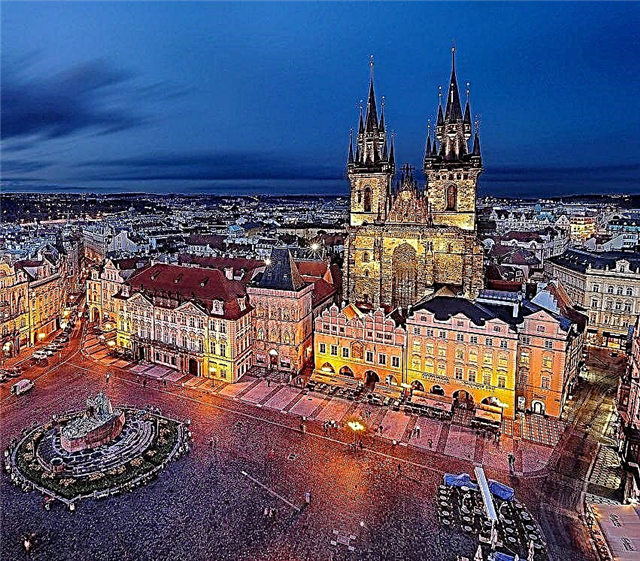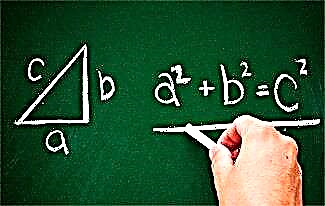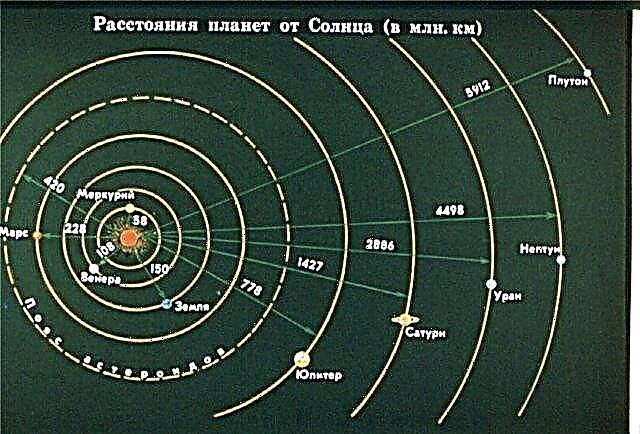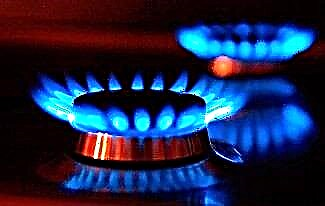In honor of the Roman God, who was in charge of agriculture, the amazing and mysterious planet Saturn was named. People strive to study every planet perfectly, including Saturn. After Jupiter, Saturn is the second largest in the solar system. Even with a conventional telescope, you can easily see this amazing planet. Hydrogen and helium are the main building blocks of the planet. That is why life on the planet is for those who breathe oxygen. Next, we suggest reading more interesting facts about the planet Saturn.

1. On Saturn, as well as on planet Earth, there are seasons.
2. One "season" on Saturn lasts more than 7 years.
3. The planet Saturn is an oblate ball. The fact is that Saturn rotates so quickly around its axis that it flattens itself.
4. Saturn is considered the lowest density planet in the entire solar system.
5. The density of Saturn is only 0.687 g / cc, while the Earth has a density of 5.52 g / cc.
6. The number of satellites of the planet is 63.
7. Many of the earliest astronomers believed that the rings of Saturn were its satellites. Galileo was the first to talk about this.
8. For the first time, the Rings of Saturn were discovered in 1610.
9. Spaceships have visited Saturn only 4 times.
10. It is still unknown how long a day lasts on this planet, however, many assume that it is just over 10 hours.
11. One year on this planet is equal to 30 years on Earth
12. When the seasons change, the planet changes its color.
13. Saturn's rings sometimes disappear. The fact is that at an angle you can see only the edges of the rings, which are difficult to notice.
14. Saturn can be seen through a telescope.
15. Scientists have not yet decided when Saturn's rings formed.
16. The rings of Saturn have bright and dark sides. At the same time, only bright sides can be seen from Earth.
17. Saturn is recognized as the 2nd largest planet in the solar system.
18. Saturn is considered the 6th planet from the Sun.
19. Saturn has its own symbol - a sickle.
20. Saturn consists of water, hydrogen, helium, methane.
21. Saturn's magnetic field extends over 1 million kilometers.
22. The rings of this planet are composed of pieces of ice and dust.
23. Today in orbit Saturn is the interplanetary station Kasain.
24. This planet is mostly composed of gases and has practically no solid surface.
25. The mass of Saturn exceeds the mass of our planet by more than 95 times.
26. In order to get from Saturn to the Sun, you need to overcome 1430 million km.
27. Saturn is the only planet that revolves around its axis faster than around its orbit.
28. Wind speed on this planet sometimes reaches 1800 km / h.
29. This is the windiest planet, because this is due to its rapid rotation and internal heat.
30. Saturn is recognized as the complete opposite of our planet.

31. Saturn has its own core, which is composed of iron, ice and nickel.
32. The rings of this planet do not exceed a kilometer in thickness.
33. If Saturn is lowered into water, it will be able to float on it, because its density is 2 times lower than water.
34. Aurora Borealis was discovered on Saturn.
35. The name of the planet comes from the name of the Roman god of agriculture.
36. The rings of the planet reflect more light than its disk.
37. The shape of the clouds above this planet resembles a hexagon.
38. The tilt of Saturn's axis is similar to that of Earth.
39. At the north pole of Saturn there are strange clouds that resemble a black vortex.
40. Saturn has a moon Titan, which, in turn, has been recognized as the second largest in the universe.
41. The names of the rings of the planet are named alphabetically, and in the order in which they were discovered.
42. The main rings are recognized as rings A, B and C.
43. The first spacecraft visited the planet in 1979.
44. One of the satellites of this planet, Iapetus, has an interesting structure. On one side it has the color of black velvet, on the other side it is white as snow.
45. For the first time Saturn is mentioned in literature in 1752 by Voltaire.
46. The lowest temperature was recorded on this planet.
47. The total width of the rings is 137 million kilometers.
48. The moons of Saturn are mainly composed of ice.
49. There are 2 types of satellites of this planet - regular and irregular.
50. There are only 23 regular satellites today, and they rotate in orbits close to Saturn.
51. Irregular satellites rotate in elongated orbits of the planet.
52. Some scientists believe that irregular satellites were captured by this planet quite recently, as they are located far from it.
53. The satellite Iapetus is the very first and oldest one related to this planet.
54. The satellite of Tethys is distinguished by its huge craters.
55. Saturn was recognized as the most beautiful planet in the solar system.
56. Some astronomers suggest that life exists on one of the planet's moons (Enceladus).
57. On the moon Enceladus, a source of light, water and organic matter was found.
58. It is believed that more than 40% of the satellites of the solar system revolve around this planet.
59. It is believed to have been formed over 4.6 billion years ago.
60. In 1990, scientists observed the largest storm in the entire universe, which just happened on Saturn and is known as the Great White Oval.

Gas giant structure
61. Saturn is recognized as the lightest planet in the entire solar system.
62. Indicators of gravity on Saturn and Earth are different. For example, if on Earth the mass of a person is 80 kg, then on Saturn it will be 72.8 kg.
63. The temperature of the planet's upper layer is -150 ° C.
64. In the core of the planet, the temperature reaches 11,700 ° C.
65. The closest neighbor for Saturn is Jupiter.
66. The force of gravity on this planet is 2, while on Earth is 1.
67. The most distant satellite from Saturn is Phoebe and is located at a distance of 12,952,000 kilometers.
68. Herschel single-handedly discovered 2 satellites of Saturn at once: Mimmas and Eceladus in 1789.
69. Kassaini immediately discovered 4 satellites of this planet: Iapetus, Rhea, Tethys and Dion.
70. Every 14-15 years you can see the edges of Saturn's rings due to the tilt of the orbit.
71. In addition to rings, in astronomy it is customary to separate the gaps between them, which also have names.
72. It is customary, in addition to the main rings, to separate those that consist of dust.
73. In 2004, when the Cassini spacecraft first flew between rings F and G, it received more than 100,000 hits from micrometeorites.
74. According to the new model, the rings of Saturn were formed as a result of the destruction of satellites.
75. The youngest satellite of Saturn is Helena.

Photo of the famous, strongest, hexagonal vortex on the planet Saturn. Photo from the Cassini spacecraft at an altitude of approximately 3000 km. from the surface of the planet.
76. The first spacecraft to visit Saturn was Pioneer 11, followed by Voyager 1 a year later, Voyager 2.
77. In Indian astronomy, Saturn is usually called Shani as one of the 9 celestial bodies.
78. The rings of Saturn in the story of Isaac Asimov called "The Way of the Martians" become the main source of water for the Martian colony.
79. Saturn was also involved in the Japanese cartoon "Sailor Moon", the planet Saturn is personified by a girl warrior of death and rebirth.
80. The weight of the planet is 568.46 x 1024 kg.
81. Kepler, when translating Galileo's conclusions about Saturn, was mistaken and decided that he had discovered 2 satellites of Mars instead of the rings of Saturn. The embarrassment was resolved after just 250 years.
82. The total mass of the rings is estimated at approximately 3 × 1019 kilograms.
83. The speed of movement in orbit is 9.69 km / s.
84. The maximum distance from Saturn to the Earth is only 1.6585 billion km, while the minimum is 1.1955 billion km.
85. The first space velocity of the planet is 35.5 km / s.
86. Such planets as Jupiter, Uranus and Neptune, like Saturn, have rings. However, all scientists and astronomers agreed that only Saturn's rings are unusual.
87. It is interesting that the word Saturn in English has the same root with the word Saturday.
88. The yellow and gold stripes that can be seen on the planet are the result of constant winds.
89. Another interesting fact is that Saturn is 13,000 km wider at the equator than between the poles.
90. Today the hottest and most zealous disputes between scientists happen precisely because of the hexagon that arose on the surface of Saturn.
91. Repeatedly, many scientists have proved that the core of Saturn is much larger and more massive than the earth, however, the exact numbers have not yet been established.
92. Not so long ago, scientists have established that needles seem to be stuck in the rings. However, later it turned out that these are just layers of particles charged with electricity.
93. The size of the polar radius on the planet Saturn is about 54364 km.
94. The planet's equatorial radius is 60,268 km.
95. An interesting fact can also be considered that 2 satellites of Saturn, Pan and Atlas, have the shape of a flying saucer.
96. Many astronomers believe that it was Saturn, as one of the most massive planets, that influenced the structure of the solar system. Due to gravitational pull, Saturn may have thrown Uranus and Neptune away.
97. Some so-called "dust" on the rings of Saturn reaches the size of a house.
98. The satellite Iapetus can be seen only when it is on a certain side of the planet.
99. In 2017, the full seasonality data on Saturn will be available.
100. According to some reports, Saturn is similar in composition to the Sun.









